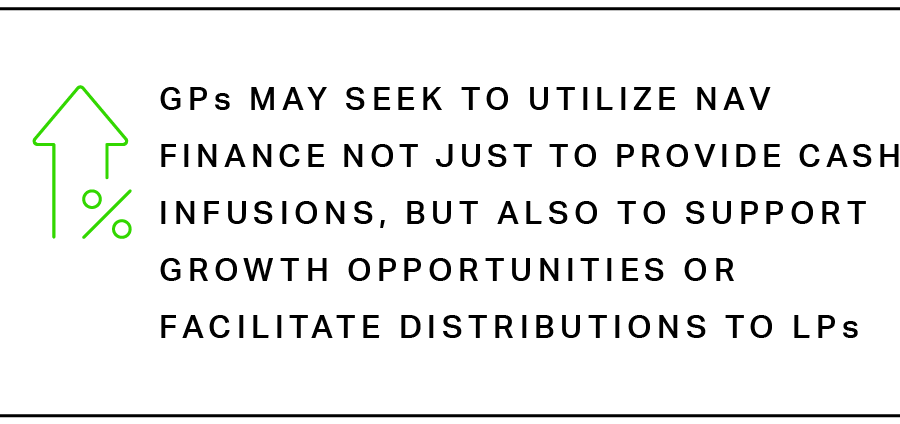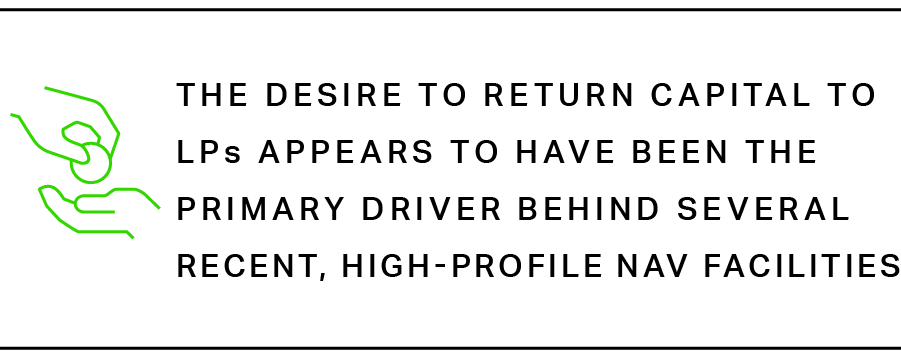First Looks at
NAV Finance

It seems like everywhere you turn, private equity industry participants are talking about NAV-based lending. And it’s not without cause. NAV finance has many virtues, which became readily apparent during the pandemic when it was one of the few sources of liquidity for private equity firms that needed to support portfolio companies through an unprecedented period of stress.
Today, NAV finance continues to present an attractive alternative, with expanding use cases. Private equity sponsors (GPs) may seek to utilize NAV finance not just to provide cash infusions to struggling portfolio companies, but also to support portfolio company growth opportunities or to facilitate distributions to investors (LPs), especially after a fund’s investment period, when the ability to call capital or borrow via commitment-based credit facilities may be limited.


Today, NAV finance continues to present an attractive alternative, with expanding use cases. Private equity sponsors (GPs) may seek to utilize NAV finance not just to provide cash infusions to struggling portfolio companies, but also to support portfolio company growth opportunities or to facilitate distributions to investors (LPs), especially after a fund’s investment period, when the ability to call capital or borrow via commitment-based credit facilities may be limited.


The desire to return capital to LPs appears to have been the primary driver behind several recent, high-profile NAV facilities. GPs continue to face fundraising challenges as their LPs are both cash-strapped and also dealing with the denominator effect that has left many institutions overallocated to private equity. A frosty IPO market has exacerbated the problem, as fewer traditional exit opportunities translate into a lack of distributions from predecessor funds.

Although, in recent years, GPs and LPs seeking liquidity have increasingly turned to secondaries transactions, that market has also slowed as the result of pricing mismatches between buyers and sellers. One of the advantages of a NAV loan is that, as a debt (rather than equity) financing, the borrower is not forgoing future upside and no final valuation has to be agreed. NAV financing is also relatively quick to put in place when compared to an equity sale. On the other hand, NAV financing is not an actual realization, and consequently there is a risk that the value of the underlying assets could subsequently drop, which in turn could trigger a variety of remedies under the NAV facility that could negatively impact the fund. A GP-led secondary, by contrast, is a real exit for the fund that does not come along with the same post-transaction risk.

The desire to return capital to LPs appears to have been the primary driver behind several recent, high-profile NAV facilities. GPs continue to face fundraising challenges as their LPs are both cash-strapped and also dealing with the denominator effect that has left many institutions overallocated to private equity. A frosty IPO market has exacerbated the problem, as fewer traditional exit opportunities translate into a lack of distributions from predecessor funds.

Although, in recent years, GPs and LPs seeking liquidity have increasingly turned to secondaries transactions, that market has also slowed as the result of pricing mismatches between buyers and sellers. One of the advantages of a NAV loan is that, as a debt (rather than equity) financing, the borrower is not forgoing future upside and no final valuation has to be agreed. NAV financing is also relatively quick to put in place when compared to an equity sale. On the other hand, NAV financing is not an actual realization, and consequently there is a risk that the value of the underlying assets could subsequently drop, which in turn could trigger a variety of remedies under the NAV facility that could negatively impact the fund. A GP-led secondary, by contrast, is a real exit for the fund that does not come along with the same post-transaction risk.

According to some reports, NAV finance has grown exponentially in recent years1, although it is not yet clear whether in the future it will become as commonplace as subscription lines or whether an upswing in secondaries, IPO, and/or M&A markets could dampen demand. Regardless, NAV finance is a tool at the disposal of GPs and LPs that many are seeking to better understand. If you are considering NAV financing for the first time, here are some issues to consider.






1. Are Your Fund Documents Silent on NAV Financing?
If the fund’s governing documents do not expressly contemplate NAV-based borrowing (as is often the case, particularly with older funds), the GP, together with its legal counsel, must consider how the borrowing provisions should be interpreted to apply to NAV finance. This will require careful analysis of the fund agreement and an understanding of the requirements of the facility, including the collateral package, the number of assets involved and whether the borrowing will occur at the fund or at a holding company or SPV below the fund. If only one or two assets are the basis for the NAV facility, the borrowing may be more akin to traditional portfolio company leverage or other inter-portfolio company transactions that are often outside the scope of the fund’s borrowing limits or other fund-level restrictions.
Cross-collateralization of the financing among all (or numerous) portfolio companies, on the other hand, could be viewed more like fund-level borrowing even if originated at a holding company or SPV level. The effect of fund and subsidiary level guarantees, equity commitment letters and other credit enhancements also need to be considered in this analysis.
Some NAV financings also seek to use LPs’ uncalled capital commitments as part of the collateral package; and the GP’s ability to pledge uncalled capital outside the context of a typical subline facility should also be carefully reviewed. The GP should consider the legal and reputational risk of proceeding with such a transaction without an amendment or some form of LP or LPAC consent.
2. If the Fund Documents Expressly Contemplate NAV Financing, What Are the Requirements/Restrictions?
If existing documents do contemplate the possibility of NAV finance, the GP should determine the level of consent required, if any, and whether the GP has a compelling explanation as to why the proposed borrowing is in the best interest of the fund. For new funds, if a GP is contemplating adding a new provision expressly permitting NAV financing, the GP should consider how the plan to put in place this sort of fund-based borrowing fits into the fund’s broader investment strategy and leverage profile.
3. The Lender and its Collateral Requirements
As NAV finance has grown, so has the universe of lenders. Credit and other special situations funds have stepped up to lend to buyout funds as banks have grown more conservative in the wake of distress in the banking sector earlier this year. Banks and credit funds are different creatures, so a GP should consider the pros and cons of each counterparty.
One notable difference is their respective approaches to collateral. Traditional bank lenders are accustomed to getting as close to the assets against which they are lending as possible, which in this context usually means a pledge of equity interests, whereas funds may be comfortable lending without being quite so close to the assets – purely based on the right to distributions with respect to the equity and underlying assets. If a pledge is contemplated, the GP should diligence potential asset-level change of control and transfer restriction issues, as well as whether, under the relevant fund documents, they have the authority to pledge equity of one company potentially for the benefit of another, and what consents are required.
4. The Universe of Investors Participating in the Assets
GPs will also need to analyze the risk/reward balance of a NAV facility in the context of investors, both within and outside of the fund. A GP should consider potential issues that may arise if some fund investors are excused or excluded from the underlying investments comprising the borrowing base or from the investments that will benefit from the borrowing. Likewise, the GP should consider the scope of outside investors that participate in the underlying investments, such as co-investors and parallel funds, and how their interests are benefitted or put at risk by the borrowing. Even if an outside investor’s allocable portion of an investment is excluded from the collateral package, there may be ancillary effects on the investor’s interests as a result of the NAV facility.
5. Interplay With Other Borrowings
A GP should also diligence to what extent, if any, a NAV facility could violate existing borrowing agreements or compromise future borrowings at both the fund level and the portfolio company level – for example, by using up any expressly limited borrowing capacity under the fund agreements, limiting the possibilities for additional or alternative back-leverage arrangements or potentially triggering a cross default in existing financings by virtue of a failure to comply with the NAV facility.
6. Repayment Mechanics
The repayment provisions of NAV facilities typically include a “cash sweep” mechanic to ensure that any cash proceeds flowing from the underlying portfolio go to repay the lender first, or at least require priority payment for the lender depending on a borrowing base or similar test. That mechanic, however, may be highly negotiated, including with respect to the particular assets from which a lender may sweep proceeds. A lender’s amenability to negotiating repayment provisions will vary depending on a variety of factors, including but not limited to the lender type, the number of assets involved, their performance and the LTV ratio.
Cash sweep tests may also depend on a periodic valuation mechanism for all or certain portfolio assets, giving rise to the potential for disputes between the lender and the GP as to asset values. A GP should also examine how repayment mechanics may interfere with the fund’s ability to recycle proceeds and/or recall distributions and consider whether it may be able to negotiate a carveout of those from the cash sweep provision in the facility documents.






1. Are Your Fund Documents Silent on NAV Financing?
If the fund’s governing documents do not expressly contemplate NAV-based borrowing (as is often the case, particularly with older funds), the GP, together with its legal counsel, must consider how the borrowing provisions should be interpreted to apply to NAV finance. This will require careful analysis of the fund agreement and an understanding of the requirements of the facility, including the collateral package, the number of assets involved and whether the borrowing will occur at the fund or at a holding company or SPV below the fund. If only one or two assets are the basis for the NAV facility, the borrowing may be more akin to traditional portfolio company leverage or other inter-portfolio company transactions that are often outside the scope of the fund’s borrowing limits or other fund-level restrictions.
Cross-collateralization of the financing among all (or numerous) portfolio companies, on the other hand, could be viewed more like fund-level borrowing even if originated at a holding company or SPV level. The effect of fund and subsidiary level guarantees, equity commitment letters and other credit enhancements also need to be considered in this analysis.
Some NAV financings also seek to use LPs’ uncalled capital commitments as part of the collateral package; and the GP’s ability to pledge uncalled capital outside the context of a typical subline facility should also be carefully reviewed. The GP should consider the legal and reputational risk of proceeding with such a transaction without an amendment or some form of LP or LPAC consent.
2. If the Fund Documents Expressly Contemplate NAV Financing, What Are the Requirements/Restrictions?
If existing documents do contemplate the possibility of NAV finance, the GP should determine the level of consent required, if any, and whether the GP has a compelling explanation as to why the proposed borrowing is in the best inzterest of the fund. For new funds, if a GP is contemplating adding a new provision expressly permitting NAV financing, the GP should consider how the plan to put in place this sort of fund-based borrowing fits into the fund’s broader investment strategy and leverage profile.

3. The Lender and its Collateral Requirements
As NAV finance has grown, so has the universe of lenders. Credit and other special situations funds have stepped up to lend to buyout funds as banks have grown more conservative in the wake of distress in the banking sector earlier this year. Banks and credit funds are different creatures, so a GP should consider the pros and cons of each counterparty.
One notable difference is their respective approaches to collateral. Traditional bank lenders are accustomed to getting as close to the assets against which they are lending as possible, which in this context usually means a pledge of equity interests, whereas funds may be comfortable lending without being quite so close to the assets – purely based on the right to distributions with respect to the equity and underlying assets. If a pledge is contemplated, the GP should diligence potential asset-level change of control and transfer restriction issues, as well as whether, under the relevant fund documents, they have the authority to pledge equity of one company potentially for the benefit of another, and what consents are required.
4. The Universe of Investors Participating in the Assets
GPs will also need to analyze the risk/reward balance of a NAV facility in the context of investors, both within and outside of the fund. A GP should consider potential issues that may arise if some fund investors are excused or excluded from the underlying investments comprising the borrowing base or from the investments that will benefit from the borrowing. Likewise, the GP should consider the scope of outside investors that participate in the underlying investments, such as co-investors and parallel funds, and how their interests are benefitted or put at risk by the borrowing. Even if an outside investor’s allocable portion of an investment is excluded from the collateral package, there may be ancillary effects on the investor’s interests as a result of the NAV facility.

5. Interplay With Other Borrowings
A GP should also diligence to what extent, if any, a NAV facility could violate existing borrowing agreements or compromise future borrowings at both the fund level and the portfolio company level – for example, by using up any expressly limited borrowing capacity under the fund agreements, limiting the possibilities for additional or alternative back-leverage arrangements or potentially triggering a cross default in existing financings by virtue of a failure to comply with the NAV facility.
6. Repayment Mechanics
The repayment provisions of NAV facilities typically include a “cash sweep” mechanic to ensure that any cash proceeds flowing from the underlying portfolio go to repay the lender first, or at least require priority payment for the lender depending on a borrowing base or similar test. That mechanic, however, may be highly negotiated, including with respect to the particular assets from which a lender may sweep proceeds. A lender’s amenability to negotiating repayment provisions will vary depending on a variety of factors, including but not limited to the lender type, the number of assets involved, their performance and the LTV ratio.
Cash sweep tests may also depend on a periodic valuation mechanism for all or certain portfolio assets, giving rise to the potential for disputes between the lender and the GP as to asset values. A GP should also examine how repayment mechanics may interfere with the fund’s ability to recycle proceeds and/or recall distributions and consider whether it may be able to negotiate a carveout of those from the cash sweep provision in the facility documents.
The current economic environment is proving conducive to the growth of NAV finance, with the technology becoming increasingly familiar to GPs and LPs alike. Just as the private equity market has grown accustomed to complex secondaries deals, knowledge, LP sentiment and fund documentation with respect to NAV lending is also evolving. NAV finance may be another arrow in the quiver of GPs looking for ways to generate liquidity, with the potential to benefit both GPs and LPs. There are unique nuances to NAV facilities, however, which can be significantly more bespoke than their subscription line counterparts. As a result, borrowers should consult their counsel early and often when embarking on their first foray into NAV finance.

